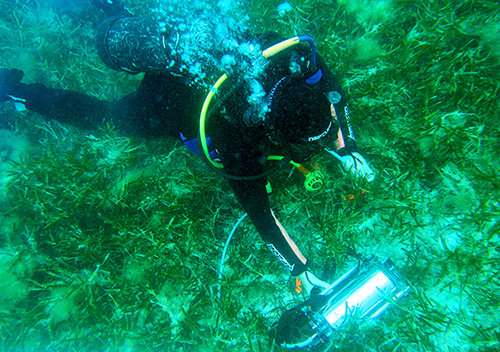Saving seagrasses from dredging—new research finds solutions

Timing of dredging is the key to helping preserve one of the world's most productive and important ecosystems—seagrass meadows, a new study led by QUT researchers has found.
The study, published overnight in Nature Communications, was led by QUT researchers in collaboration with seagrass experts at Edith Cowan and James Cook universities.
Lead researcher, QUT's Dr Paul Wu, has developed a way of predicting the ideal time to dredge in order to give seagrass the best and quickest chance of recovery.
Dr Wu said dredging was a source for seagrass loss and timing of dredging determines if seagrass will recover and how quickly.
"This is called an ecological window," Dr Wu said.
The team of researchers studied 28 seagrass meadows around the world.
Seagrasses provide shelter and food to an incredibly diverse community of life, from the tiniest of marine creatures, to fish, turtles, dugongs, other marine mammals and birds.
It is also estimated one hectare of seagrass can absorb 35-times as much carbon dioxide as a hectare of Amazon rainforest, as well as produce 100-thousand litres of oxygen per day.
Despite this immense value, large areas of seagrass are disappearing every year because of accumulated stressors, including human activities, most notably dredging.
Dr Wu is an Associate Investigator with the ARC Centre of Excellence for Mathematical and Statistical Frontiers (ACEMS) within QUT's Mathematical and Statistical Sciences Faculty.
He has developed an advanced statistical model to predict when dredging is least likely to damage seagrass.
Dr Wu said the model could be used globally, not just in Australia.
"Our model can provide up to a fourfold reduction in recovery time, and up to a 35 per cent reduction in local extinction risk for seagrass species," said Dr Wu.
"So if the seagrass can come back more quickly, or minimise the impact, that will also help everything that depends on it."
The modelling also takes into account another very important factor – resilience.
Some areas of seagrass are stronger and healthier and can handle more stress. The modelling looks at how resistant a system is to change, how quickly it can recover, and considers the probability of extinction in local populations.
"Being able to tell the difference between a site where you can do some dredging and seagrass will come back, a site that is at its limit and you shouldn't do any more to it, or a site that's already dying and it doesn't make a difference what you do to it, is very important," said Dr Wu.
There are dozens of seagrass species around the world. They typically grow along gently sloping, protected coastlines.
Seagrasses depend on light for photosynthesis, most commonly found in shallow depths where light levels are high.
Dredging can significantly reduce the amount of light reaching the seagrass.
Dr Kathryn McMahon (pictured diving above), Deputy Director of Edith Cowan University's Centre for Marine Ecosystems Research, said seagrass is much like terrestrial plants.
"There are natural phases of seagrass growth and reproduction, therefore, at particular times seagrasses could be more or less vulnerable to dredging pressures," Dr McMahon said.
"By combining our knowledge of the biology of seagrasses with natural environmental fluctuations and human pressures we identify the best time to minimise long-term impacts for human activities."
Dr Wu believed proponents of dredging and coastal development would be among those who could benefit from the use of this model.
"The model allows dredging and coastal development to move forward, but helps mitigate the environmental impacts on seagrass and the many ecosystems that depend on it," said Dr Wu.
Dr Wu said his Bayesian network model combines both the use of data with expert knowledge.
"As with many ecosystems, there isn't enough data to fully understand the system," Dr Wu said.
"The processes are too complex and there is too much variability in nature. We bolster the data we have with expert knowledge from seagrass scientists who dive on the seagrass beds, studying them and taking samples, decades of valuable experience."
Those experts come from the School of Sciences and Centre for Marine Ecosystems Research at Edith Cowan University, the Western Australian Marine Science Institution in Perth, the UWA Oceans Institute and School of Biological Sciences at the University of Western Australia, and the Centre for Tropical Water & Aquatic Ecosystem Research at James Cook University.
"What makes the model even more important is that it isn't limited to just seagrass. It could be used to model other natural ecosystems under stress, like mangroves and coral reefs," Dr Wu said.
JCU's Dr Michael Rasheed said the model was more practical than existing systems.
"Global trends indicate favourable windows in autumn and winter where dredging causes the least damage," Dr Rasheed said.
"Ideally, impact assessments of dredging campaigns do still need to be customised for specific meadows at specific periods in time and incorporate uncertainty associated with forecasted future conditions in the area."
More information: Paul Pao-Yen Wu et al. Timing anthropogenic stressors to mitigate their impact on marine ecosystem resilience, Nature Communications (2017). DOI: 10.1038/s41467-017-01306-9
Journal information: Nature Communications
Provided by Queensland University of Technology





















